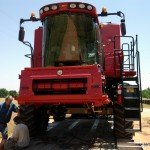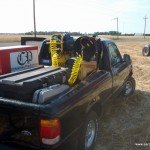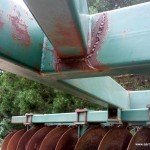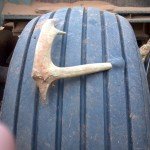This review was originally published on May 1 on the Verizon Wireless Midwest Area site at http://vzwmidwestarea.com/htc-one-m8-farm-office/.
Verizon recently let me spend a couple weeks with the new HTC One M8. Announced in March and available earlier this month, HTC’s new flagship phone combines beautiful hardware design and high end specs with the latest version of Sense, HTC’s Android overlay. Using Android with Google Voice makes it simple to transfer all my apps and phone calls from one device to another, so I’ve left my Galaxy Note 3 on my desk and carried the One exclusively for the last several days.

The phone is big. It’s not as big as the Note 3, but it’s certainly larger than most phones. The case is aluminum and it rivals the iPhone in build quality and hardware design. Unfortunately, it doesn’t have a removable back, which means it’s stuck with the 2600 mAh battery. The One doesn’t have the physical home button that plagues most of the recent Samsung phones, HTC having opted instead for the soft buttons that are the mark of a good, modern Android experience. The power button and IR remote are on the top of the phone, a microSD slot sits above the volume rocker on the right side of the phone, while the headphone jack and micro-USB port are on the bottom.
The most noticeable difference between the One and other phones I’ve used is HTC Sense. The One is the first phone to ship with Sense 6.0 and the typography is beautiful. While it’s not as clean as the stock Android experience, the Sense enhancements don’t seem to get in the way nearly as much as Samsung’s TouchWiz. The most obvious change to the launcher is BlinkFeed, a social feed aggregator that puts highlights from Facebook, Twitter, Google+ and more on a screen to the left of the home screen where Google Now normally appears on stock Android devices. I found the default keyboard to be unremarkable, and quickly installed SwiftKey.

The cameras on the One are the most notable hardware feature. The 5MP front camera is capable of HD video capture, and while it’s not really my thing, the filters and editing abilities of the camera software will make this phone a popular choice for anyone wanting to take great selfies. Realizing that there’s much more to a good camera than the megapixel count, HTC has put what they call a Duo camera on the back, comprising a primary camera with an advanced sensor and a secondary camera used to capturing depth information. This two-camera approach allows for some very delightful effects and the ability to refocus parts of the picture after the picture is taken, like this picture of my son on the see-saw after the Easter egg hunt.
On the farm, the camera on my phone is one of the most important tools I have. I’m constantly snapping pictures of part numbers, handwritten notes, receipts and surveys of crops for instant upload to Dropbox and eventual archival in Evernote. The 360° panorama feature on the new HTC One makes crop surveys not only fun but beautiful.

It’s tough to prove with the time I’ve had, but I sure feel like this phone seems to get better service on the farm than my current and previous phones. The One can make calls and maintain data service in places where my Note 3 and Galaxy Nexus wouldn’t be able to dial out, much less be able to check email.
In the office and around the house, I’m always listening to podcasts with Doggcatcher and catching up on the news with the Press RSS reader. The large, bright screen and the loud, clear speakers make consuming this content a joy, but battery life will vary. A full charge lasted all day during my normal weekday work days, but it only lasted until about 6 p.m. on an active Saturday.
In summary, when I send this HTC One back to Verizon, I’m going to miss a few things. I’m going to miss the beautiful hardware. I’m going to hate going back to the physical home button on my Note 3. I’m probably going to double-tap the screen of my Note 3 to try to wake it up, a feature that I first found gimmicky but learned to love on the HTC One. Most of all, I’m going to miss the cameras.
I’m not going to miss the lack of expandability. There is no way to swap out an extended battery, which is a deal breaker for me. I won’t miss HTC Sense or BlinkFeed, as I still prefer the simplicity of the stock Android experience.
The new HTC One M8 is the most beautiful Android device I’ve yet seen. With snappy performance and amazing cameras, it’s the phone I’m going to start recommending to friends and family.





 It’s been nearly three months since my father left me with the farm. It was precisely one year ago today when he saw my newborn son in the hospital. While we were watching Nolan get passed from family member to family member in the birthing suite, he told me, “You have achieved immortality.” I thought about that a lot today as I sat today for 14 hours on the tractor, stirring up as much dust as the 1/2″ we received last week would allow.
It’s been nearly three months since my father left me with the farm. It was precisely one year ago today when he saw my newborn son in the hospital. While we were watching Nolan get passed from family member to family member in the birthing suite, he told me, “You have achieved immortality.” I thought about that a lot today as I sat today for 14 hours on the tractor, stirring up as much dust as the 1/2″ we received last week would allow.


















